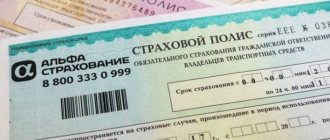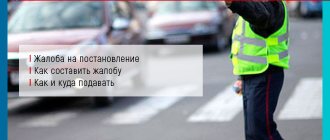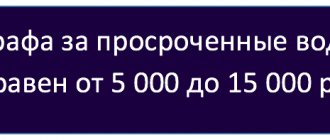Good afternoon, dear reader.
This article will talk about the rules for using seat belts in modern vehicles and about fines for the driver and passengers for not wearing a seat belt.
A seat belt is a car safety system, which, on the one hand, is quite simple in design, and on the other hand, the most common.
Let's consider the rules for using seat belts by drivers and passengers:
- Rules for using seat belts: for the driver;
- for the passenger;
- for a child.
- for the driver;
What types of fines are provided for passengers?
There are several offenses and fines for them related to seat belts:
- If the passenger does not fasten his seat belt - 500 rubles.
- If a passenger sitting in the back row of seats does not fasten his seat belt - 500 rubles.
- If the passenger pretended to have a seat belt fastened, but in fact just put it on top – 500 rubles.
Fine for an unbelted driver
If a person driving a car does not wear a seat belt and is caught red-handed by a traffic police officer, then as of 2021, he will be forced to pay a fine of 1 thousand rubles. You can check the exact information in Article 12.6 of the Code of Administrative Offenses of the Russian Federation.
Such a violation of traffic rules is recorded when the driver of any type of car, passenger car or truck, which can be driven on a public road, is not protected by a special belt, as indicated in the instructions.
Appeal
You can appeal the actions of a traffic police officer in court in the following order:
- Draw up a statement of disagreement with the written protocol.
- Prepare evidence of your innocence (witness testimony, photos or videos, etc.).
- Take the application with attachments to the court or addressed to the head at the place of duty of the traffic police officer who issued the fine for not wearing a seat belt. Documents can be sent by registered mail through the post office.
- Wait for a response to the complaint. The traffic police must consider the application within 10 days (Article 30.5, paragraph 1 of the Administrative Code). The court examines the case materials after receiving them for 2 months (Article 30.5, paragraph 1.1 of the Administrative Code).
In order for the case to be resolved in favor of the plaintiff, the application must be correctly drawn up. In 2021, it should contain the following information:
- name of the judicial authority where the documents are submitted;
- information about the applicant (full name, address);
- detailed description of the situation;
- information about the vehicle that was stopped;
- references to laws that confirm the plaintiff’s case;
- indication of documentary evidence of the absence of an offense;
- date of preparation of the paper and personal signature.
The document must be drawn up in an official business style. It is not allowed to use colloquial words, obscene expressions, or curses. The application is submitted to the court office, where a mark indicating its acceptance is made. Next, a date and time will be set for a hearing, at which the plaintiff must attend in person. If this is not possible, a representative of the applicant who has a notarized power of attorney may appear at the meeting.
Applications to appeal a fine for not wearing a seat belt can be found here.
Fine for an unbelted passenger
Since pedestrians and passengers in most cases have not graduated from driving schools or passed exams on knowledge of traffic rules, they are not aware of many of them and, in addition, do not think about their own safety.
There are reasons for this:
- They did not memorize all the traffic rules, like people who took their license.
- They don't have any special IDs.
- They do not drive a car that is considered a source of increased danger.
- They practically never encounter traffic police officers.
However, the norms of the Code of Administrative Offenses and Traffic Regulations establish provisions that protect the lives of both people in the car and those walking along the street. Therefore, if a traffic police officer sees that a passenger is sitting in a passing vehicle and he is not protected by a belt, then by law he can fine him 500 rubles. The amount of the fine is the same in all cases.
Moreover, it can be written out not only if a person was driving unprotected by a seat belt in the second row of seats in a car, but even if he was traveling in a taxi or on an intercity bus.
How to seat belt your children without getting fined
You will have to pay the most for unbelted children in the car, so you need to figure out how and with what to secure them in the seat, and also up to what age.
The traffic rules do not put forward strict restrictions on fastening methods, but only offer options:
- special child seat;
- child adapters for adult belts;
- children's belts.
Typically, children under 3 years of age are transported in child seats, while older children are transported using adapters on belts. Although there are special chairs that are designed for a child aged 12 years, for some reason they are almost never used.
It is interesting that clause 22.9 of the traffic rules puts forward such requirements only for those situations when there is a child under 12 years old in the car. Apparently, older children are treated like adults, although from a legal point of view, persons become adults at the age of 16. But based on the Traffic Rules, we come to the conclusion that a fine of 3,000 rubles is imposed only for children under 12 years of age who are not properly restrained , and teenagers from 12 to 16 are “considered” adults, and therefore for them its amount is limited to 1,000 rubles.
Fine for not wearing a seat belt in the back seat
If the design of the car provides that passengers located in the rear seats of the vehicle can fasten seat belts, but they do not do this, then this is classified as disregard for traffic rules. If this fact is discovered by a traffic police officer, the violator will have to spend 500 rubles from his own pocket. You can check this point in Article 12.29 of the Code of Administrative Offenses of the Russian Federation. But depending on the circumstances, instead of a fine, only a warning in written or oral format may be applied.
If a car has seat belts installed on all seats, then no matter where the passenger sits, he must fasten them. If this rule is violated, then a fine will be collected not only from the fellow traveler, but also from the person who was driving the car. Moreover, the second one will cost twice as much. This is indicated in Article 12.6 of the Administrative Code.
Reference! Traffic police officers cannot issue a fine or draw up a report on a person who is under 18 years of age.
Why is it dangerous to drive without a seat belt fastened?
In the event of a collision, a person is exposed to serious danger. You can only stay behind the wheel at a speed of 5 km/h. If it is higher and amounts to 60 km/h, then in the event of an accident the driver is subjected to a load of 3 tons. As the speed increases, the pressure force also increases significantly. Almost no one can survive in such a situation.
The safety belt is the salvation. The Japanese determined that in 75 out of 100 cases of a collision, such a simple design, not counting the pillow, helps to avoid the irreparable. When a vehicle rolls over, the survival rate increases to 91.
The following information also speaks about the dangers of not wearing a seatbelt. In a frontal impact, a person receives the same injuries as when falling onto a hard surface from a height:
- At a speed of 40 km/h – 6.3 m;
- 60 km/h – 14 m;
- 80 km/h – 25 m.
According to world statistics, every year 26 thousand people die on the road for only one reason - not wearing a seat belt. Their use reduces the risk of death by 65% among front seat passengers and 75% among rear seat passengers. For this reason, children receive 3.5 times more various injuries as a result of accidents. And of the total number who died on the roads, 29% were due to this violation.
Fine for wearing a seat belt over the top
There are still disputes among car owners about the correctness of fastening a seat belt. For example, the belt is passed only over the head and the lumbar strap is omitted.
This situation is not explained in detail in the traffic rules. Although in the case of child car seats or other child restraint structures, it is indicated that everything must be done in accordance with the instruction manual.
As for motorists, if their body is clearly secured with a special strap and the instrument panel indicates that the belt is fastened, then there is in fact no administrative violation.
But the law in this case is clearly not on the side of the drivers. Most often, people have to incur financial losses to pay off the fine.
Distribution of Responsibility
Who should always be punished when traveling with violations? The order is:
- the driver is responsible for an unbelted passenger in all cases;
- an adult sitting in the cabin - only if he is not restrained.
Wherein:
- the number of unfastened ones when punishing the driver does not matter, only a single rate is taken;
- A parental fine is not imposed on a passenger for not fastening his child’s seat belt; the driver pays for it.
But the heaviest punishment if the seat belt was not fastened is a criminal case and imprisonment. This happens when a serious accident occurs along the way. Therefore, it is more important for partners of road life to follow all the rules, and not for traffic police inspectors.
If you find an error, please select a piece of text and press Ctrl+Enter.
Didn't find the answer to your question? Find out how to solve exactly your problem - fill out the form below or call right now: +7 (ext. 697) (Moscow) +7 (ext. 281) (St. Petersburg) +8 (ext. 198) (Russia) It's fast and free!
Is there a discount on the fine?
The only option to incur the cost of repaying a fine in a smaller amount is to pay it immediately. If you do this before the expiration of 20 days from the date of registration of the decision on violation of the traffic rules, then its cost will be halved. That is, when paying off a fine in the first days, a discount of 50% is provided in accordance with Article 1 of Law No. 437-FZ of December 22, 2014.
If a person does not agree with the legality of the issued decision, then he has 10 days to appeal it. This is stated in Article 30.3 of the Code of Administrative Offenses of the Russian Federation. If this action was not taken, then a specific period is allotted for payment of the fine - 2 months. Starting from the 21st day you will have to pay the full cost.
Opportunity to challenge
If a traffic police officer stops a vehicle and establishes a violation, he draws up a report and issues a fine. You can pay it at any bank branch or through the Gosusug website.
A situation often arises when a driver disagrees with the verdict of a traffic police officer. In this case, you can submit a written complaint to the head of the traffic police in your region with a detailed description of the situation, date and signature. You can file a claim in free form.
ATTENTION! The consideration of the complaint will be facilitated by video recording. In this case, one camera should record what is happening in the cabin, the second is aimed at the road. At the same time, the traffic police officer is not required to have a video recording of the violation; a completed protocol is sufficient.
Many drivers insist that the belt was removed after the car was stopped. It is impossible to prove this on the spot without video footage. If you categorically disagree with the inspector’s decision and are dissatisfied with the response to the claim, your only option is to go to court and find a good lawyer.
Who pays the fine for a passenger not wearing a seat belt?
The traffic rules in paragraph 2.1.2 as of 2021 state that in a moving car, all people in it must wear a seat belt. And the person at the helm and all the other passengers. Failure to comply with this provision will result in administrative liability.
However, paragraph 5.1 states that passengers should protect themselves with a seat belt only if they are provided in the transport itself. Thus, if a person did not use them, but they are there, then a fine or a warning may be presented for the first time.
In 2021, if a passenger in a moving vehicle is not wearing a seatbelt, then not only he, but also the driver is to blame. But for these two categories of persons the amount of the fine is different. According to Article 12.6 of the Code of Administrative Offenses, the person driving will incur monetary costs in the amount of 1 thousand rubles, and the person sitting next to him or behind him will incur 500 (this is indicated in Article 12.9 of the Code of Administrative Offenses).
The collection of a fine from the driver is processed only once, even if there were several unbelted people in the vehicle. But at the same time, protocols are issued separately to each passenger.
Minibus taxis usually have restraints only at the driver's seat and the seat next to it. When driving this type of transport, you must use seat belts for their intended purpose. If this rule is violated, then neither the driver nor the passengers will be able to get rid of a fine. In the cabin, restraint devices are most often present only on routes that involve traveling from one city to another. In such a case, it is also important to drive with your seat belt fastened.
Who is exempt from punishment?
The legislation identifies several categories of persons who are exempt from punishment while driving a car. These include:
- Instructor during a training ride . Confirmation in this case is a certificate of the right to learn to drive vehicles.
- Disabled person. Confirmation is a document confirming the disability of the person driving the vehicle.
- Drivers and passengers of special vehicles . In this case, the car must be equipped with all the necessary special signals (ambulance, police, fire service).
It should be noted that public transport passengers are subject to punishment for violating this rule. However, not all public transport is equipped with the necessary system.











